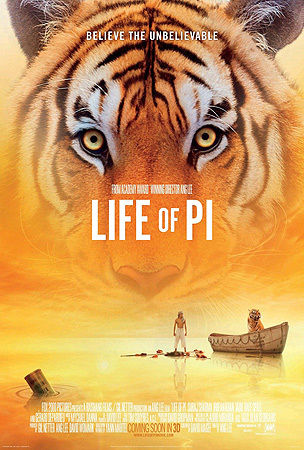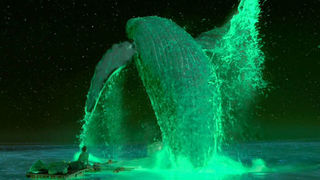What Do The Animals Represent In Life Of Pi

Source: Fox 2000 Pictures/Fair Use Rights
Based on the all-time-selling novel past Yann Martel, this bold and remarkable film is an adventure set in the realm of magical realism and centers on an Indian boy named Pi Patel, the son of a prudent and cautious zookeeper. The picture is directed past Ang Lee, who brought us the breathtaking romantic swordplay in "Crouching Tiger, Hidden Dragon"—which won 10 Oscar nominations, becoming the first Asian picture and only the seventh strange-language offering to always go a nod for Best Picture.
But first, for the very few who oasis't seen the picture or read the book—SPOILER Alert! Don't read this unless y'all've seen or read the Life of Pi.
In the story, which starts with the obligatory cute prologue about an precocious boy, the family decides to motion from Republic of india to Canada, bringing many of the animals with them. When the freighter carrying the family hits a storm, the stage is set for the master human action—Pi is left adrift on a 26-foot lifeboat, lost in the Pacific Bounding main, in the company of a zebra, a hyena, an orangutan, and a 450-pound Bengal tiger named Richard Parker—all vying in a grim competition for survival. Information technology should be noted that this project has long been considered unfilmable due to the concept, equally a long line of directors (including M. Night Shyamalan) were attached to the project and every single one jumped send.

Source: Fox 2000 Pictures/Fair Use Rights
In terms of product challenges and a tightly constrained budget, Ang Lee was forced to wrestle with a tiger of his ain. Shooting on h2o can literally drown a production in problems, delays, and cost overruns—just await at the tribulations of Kevin Costner, who flopped with Waterworld afterward burning through a $175 one thousand thousand budget. To pull off the movie's extensive aquatic sequences, the filmmakers had to build the world'south largest cocky-generating wave tank.
Now, here's the masterstroke of innovation—Lee decided to embrace 3D, fifty-fifty afterward a relatively fruitless foray into special effects with The Hulk franchise. Here's why it was a spectacularly gutsy move to rely and so heavily on computer graphics—3D has always lent a subtle artificial quality to imagery that prevents the suspension of disbelief.
In the computer blitheness business organization, the most pronounced grade of this effect is called the "Uncanny Valley". It's a hypothesis by Japanese robotics professor Masahiro Mori, who proposed that when homo replicas wait and deed nearly, but not quite perfectly, like actual human beings, it causes an enteric response of revulsion; the "valley" refers to a dip in a graph of the condolement level of human observers.
All the same, the success of CG in films like "Rise of Planet of the Apes" likely encouraged Lee to bet that the engineering would be ripe for animating subtle emotional reactions in animals. That bet paid off. Not only were the orangutan and tiger exquisitely portrayed in terms of facial emotions, like an orangutan pensively looking over the sea thinking near a lost child. The filmmakers even did motion capture on four real-life tigers who were on prepare. Also, 3D is ideally suited for rendering a hypnotically beautiful roiling ocean.
Every bit a result, the motion picture dramatically renders the distance between Pi and the tiger, the restricted space of the lifeboat, and the overwhelming countless horizons of the ocean all around them. For this reason, this rare film adaptation is actually more entertaining than the book. Even so, Lee never tries to show off with those digital effects; he controls them with a firm hand, forcing them to serve the telling of the story unobtrusively. Incidentally, I've sailed, and no pic has meliorate captured the suffocating, claustrophobic feeling of a tempest or the perfection of a graceful nighttime sailing through a warm and welcoming sea.
The director treats u.s.a. to some truly magical images filled with regal whales and the reflection of a tapestry of stars over a calm and peaceful sea. This is computer graphics taken to the level of visual poetry, a demonstration of what the medium tin practice if yous permit your imagination run free, that goes far past Avatar and Hugo. This film is an artistic triumph that rivals masterpieces like Kurosawa's Dreams and Bertolucci'south Stealing Beauty in terms of cinematic genius.

Source: Fox 2000 Pictures/Fair Apply Rights
Simply as the exquisite beauty of the ocean is revealed just beneath the drama unfolding on the lifeboat, the true meaning of the film lies gently beneath the surface of the story. The story is and so moving that fifty-fifty President Barack Obama, in a letter to the author, described it as "an elegant proof of God, and the power of storytelling".
To understand the precious stone of wisdom cached deep within the story, which is pronounced to be "a story that will brand yous believe in God," we demand to understand that the story is actually about wrestling not with a physical tiger, merely metaphoric one—with questions of meaning and faith. This story is a Gedankenexperiment for the worst-instance scenario, a modern-day story of Job, all virtually how you can observe spirituality and the pregnant of life in the throes of all that is horrible and terrible in the world today. It is by surviving and making sense of all that goes wrong in the world, that uncovers the significant of man.
The moral of the story is pretty clear and revealed at the cease when Pi is forced to tell an alternating version of the story to Japanese investigators—with a sailor with a cleaved leg, a French melt, Pi, and Pi's mother. Eventually, we realize that the zebra is the crewman, the hyena is the melt, and the orangutan is Pi's mother, and the tiger, Richard Parker, is actually Pi. The details of cannibalism and savagery are gruesome. Finally, Pi only asks the author, "Which story exercise you prefer?"
Conspicuously, Pi preferred the better story, a massive extrapolation of positive idea, that leads him to make sense of things, that carries him to a new life with a loving married woman and family. The other story, where humans are reduced to cardinal terror, could atomic number 82 but to a brutally shattered life. In this story, yous could see the entire story as an abandonment by God; just at the same time, information technology becomes evident that God was really present at every moment. And in the end, he realizes that Richard Parker is actually his savior.
Richard Parker's real name, lost due to a clerical mistake, is "Thirsty." And where else, likewise lost in a life raft in the middle of the sea, can you be surrounded by water and still die of thirst? In the aforementioned way, God is actually all around united states of america, and withal, so many of usa are unable to receive the manna of heaven. In Hindu civilisation, water symbolizes the "body of water of life,'" with all living creatures existing equally one contiguous trunk. The sea torments Pi with waves, threatens him with sharks, and even robs him of his family. At the aforementioned time, the sea also gives him life. It rains flying fish upon him, it grows a magical garden of algae, and in the end, bestows the gift of wisdom. Fifty-fifty Pi'due south proper name, Piscine, is afterwards a swimming pool—an object built to agree water, the h2o of spirit and God.
The characters in the Life of Pi, like in whatever dream because film is substantially collective dreaming, are all actually components of the self. At a college level, the Tiger is Pi'south primal self, the orangutan represents universal dearest—as demonstrated by a protective mother, the brutal hyena is the malevolent cook who is the shadow, and the timid zebra is a young sailor with a broken leg, which represents the innocence of youth and the start to die. All are essential for becoming who nosotros are.
However, the nigh important component of the self is the raft, which represents his organized religion. It is something that he has to construct by himself to be constructive. The through-line, the spine of this tale, is that information technology is his raft that never forsakes him. More than than any other part of the tale, it is the invisible forcefulness that finally brings him to safe and the force that transforms him into the individual he finally becomes.
Our challenges are what help to define us; what guides us to become more. What greater challenge tin there be than trapped with a ferocious tiger? More so, if that tiger is your own fear, anxiety, low, desolation, and despair. It is our faith that helps us cross the vicious and endless body of water. This is a message for all entrepreneurs and innovators every bit well, never give up your religion—religion in yourself, religion in your vision, faith in a amend world.
In the final analysis, just as pi is a mathematical construct that tin can never exist fully comprehended, the Life of Pi is substantially unfathomable; equally is the battle between religion, scientific discipline, and spirituality. However, just as Pi finds peace within—"Solitude began. I turned to god. I survived"—perhaps the terminal message of the pic is one that simply urges united states to find peace inside as well.
Source: https://www.psychologytoday.com/us/blog/the-tao-innovation/201211/meaning-faith-and-the-life-pi
Posted by: morganknor1997.blogspot.com

0 Response to "What Do The Animals Represent In Life Of Pi"
Post a Comment